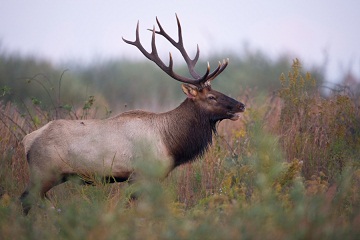BY Kevin Kelly
FRANKFORT, Ky. – Where there were no elk two decades ago in Kentucky, an estimated 10,000 or more now roam freely.
A landmark restoration effort re-established an elk herd in the state’s scenic southeastern region and created one of the most sought-after hunting opportunities east of the Rocky Mountains.

“Our elk herd is doing fantastic,” said Tina Brunjes, deer and elk program coordinator with the Kentucky Department of Fish and Wildlife Resources. “The harsh winter wasn’t enough to bother it.”
Hunters looking for a chance to check a Kentucky elk hunting adventure off their bucket list have until midnight (Eastern time) April 30 to enter this year’s quota hunt drawing. Completing the online application at fw.ky.gov well ahead of time is encouraged to avoid the expected last-minute rush.
Kentucky residents and those living out-of-state are eligible to apply for as many as two of the four permit types but can only be drawn for one. Each application costs $10.
Kentucky Fish and Wildlife will issue 1,000 general quota hunt permits and 10 youth permits this year through a random computer drawing conducted in early May by the Kentucky Commonwealth Office of Technology. Results will be posted online at fw.ky.gov.
Kentucky’s elk herd is the largest east of the Rocky Mountains and more than all the states east of the Mississippi River combined. The elk restoration zone in southeast Kentucky covers 16 counties and more than 4 million acres.
“The abundance and accessibility of Kentucky’s elk continue to produce high hunter success rates,” Brunjes said.
Eighty-eight percent of bull elk hunters using a gun last year enjoyed a successful hunt, while 69 percent of the hunters utilizing archery equipment successfully harvested a bull. The success rate for cow archery hunters was 46 percent last year but almost 78 percent among hunters using a firearm for cow elk.
“I think hunters will find this year to be very similar to last year,” Brunjes said. “You are going to have to work for it. You may not be able to go out opening morning, harvest your elk and be on the road by noon.
“The elk are there but some of the old cows that are leading these herds have been through 13 seasons now. I would encourage anyone who is truly a passionate bow hunter looking for a test to put in for that cow elk archery tag because you will earn that cow elk.”
The season limit of 250 bulls and 750 cow elk is unchanged from last year, as is the allotment among tag types.
Kentucky Fish and Wildlife will issue 150 firearms permits and 100 archery/crossbow permits for bulls; 460 firearms permits and 290 archery/crossbow permits for cow elk.
Demand is greatest for the bull firearms permit and lowest for the cow archery hunts.
Kentucky residents applying for a cow archery tag had a 1 in 13 chance of being drawn last year compared to 1 in 134 for bull firearms.
The bull elk firearms seasons are spread over two separate, weeklong hunts in October while the cow elk firearms seasons are split into two weeklong hunts in December.
A special bull archery season opens before the firearms season.
Hunters ages 15 and younger can apply for the youth-only quota hunt during the same application period as the general elk quota hunt drawing. They may also apply for the general quota elk hunt drawing, but cannot be drawn for both in the same year.
“The youth-only option does not appear until the child’s birthday is entered in the drawing application process,” Brunjes said. “The youth permit is good during all seasons and it’s an either-sex permit. There’s more opportunity to hunt with that permit.”
-30-
The Kentucky Department of Fish and Wildlife Resources manages, regulates, enforces and promotes responsible use of all fish and wildlife species, their habitats, public wildlife areas and waterways for the benefit of those resources and for public enjoyment. Kentucky Fish and Wildlife is an agency of the Tourism, Arts and Heritage Cabinet. For more information on the department, visit our website at fw.ky.gov.


Be the first to comment